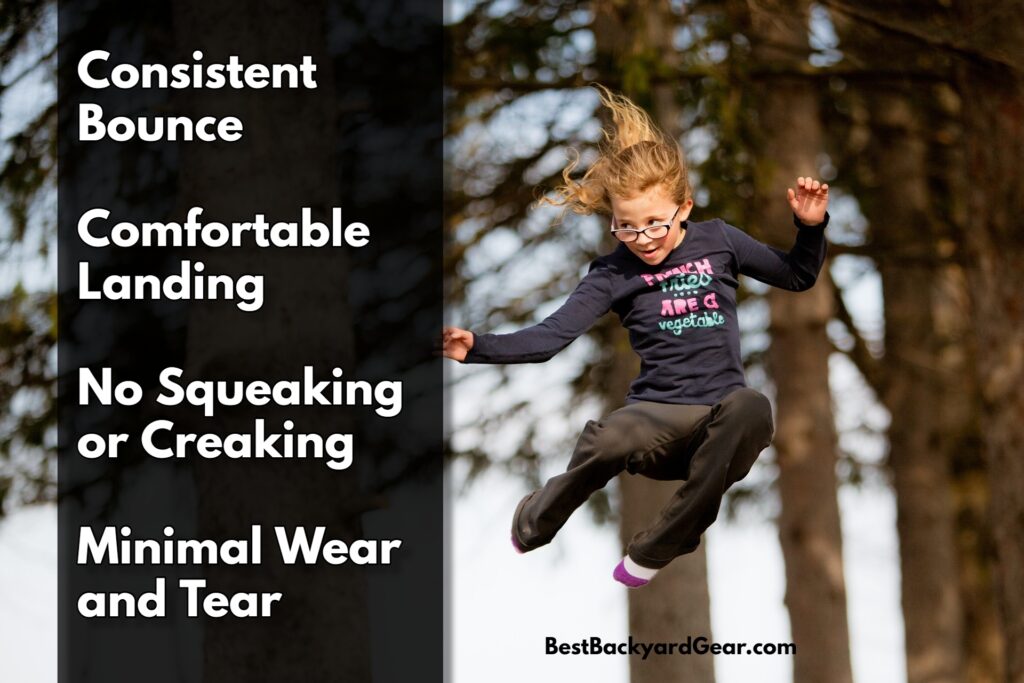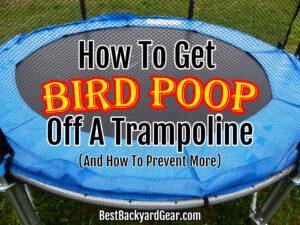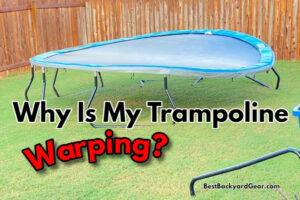Trampolines are a popular outdoor activity that provide a fun and unique way to exercise, socialize, and enjoy the outdoors. However, one question that many trampoline owners often ask is whether or not they need to break in their new trampoline. In this blog post, we’ll discuss the idea behind breaking in a new trampoline, whether or not trampolines get bouncier as they age, and the roles of the mat and the springs in relation to what makes a trampoline bouncy.

Breaking In A New Trampoline: Is It Even Necessary?
The question of whether or not you need to break in a new trampoline is a common one, and many trampoline owners do believe that it is necessary to do to “achieve maximum bounciness”.
The concept of breaking in a trampoline is similar to breaking in a new pair of shoes. Essentially, the idea is to use the trampoline regularly for a period of time to allow the mat and springs to settle into their optimal position and provide maximum bounce. (See the section on “What Is Optimal Bounce?” for more on this.)
However, there is some debate as to whether or not breaking in a trampoline is actually necessary. Some trampoline manufacturers claim that their products are pre-stretched and do not require breaking in, while others recommend a period of use before the trampoline reaches its optimal level of bounciness.
Ultimately, whether or not you choose to break in your new trampoline is a matter of personal preference. If you do decide to intentionally break it in, it is recommended to use the trampoline regularly for a period of several weeks to allow the mat and springs to settle. Honestly, this should be a pretty easy and “natural” task; it is not hard to get your kids to jump a lot on a new trampoline!
How Do You Know When A Trampoline Is Broken In?
It can be difficult to know exactly when a trampoline is properly broken in, as the process can vary depending on a number of factors, such as the size and weight of the trampoline, the quality of the mat and springs, and how often it is used. There are, however, a few signs that can indicate that a trampoline has been adequately broken in and is performing at its best (and remember, this can be right when you buy it in some cases):

1. Consistent Bounce
When a trampoline is properly broken in, the bounce should be consistent and predictable. The mat should feel responsive and flexible, and the springs should provide a good level of tension that is balanced across the surface of the trampoline.
2. Comfortable Landings
3. No Squeaking or Creaking:
4. Minimal Wear and Tear
A trampoline that is properly broken in should show minimal signs of wear and tear, such as sagging or stretched-out springs, holes or tears in the mat, or damage to the frame. Regular maintenance and care can help to ensure that a trampoline remains in good condition over time.
While there is no hard and fast rule for when a trampoline is properly broken in, paying attention to these signs can help to ensure that the trampoline is performing at its best and providing a safe and enjoyable experience for users.
Do Trampolines Get Bouncier as They Age?
Another common question that trampoline owners have is whether or not trampolines get bouncier as they age. There are several factors that can impact the bounciness of a trampoline over time. Each leads to that trampolines that get LESS BOUNCY as they age, not MORE bouncy.

Another factor is the amount of use that the trampoline receives. Regular use can cause the springs and mat to stretch out, which can lead to a decrease in bounciness over time. (You can remedy this by regularly tightening the springs or replacing them when necessary).
Finally, weather conditions can also impact the bounciness of a trampoline. Extreme temperatures or exposure to the elements can cause the mat and springs to wear out more quickly, which can lead to a decrease in bounce.
The Roles of the Mat and the Springs in Relation to Bounciness
The bounciness of any trampoline is largely determined by two key components: the mat and the springs.
The mat and the springs work together to create the trampoline’s bounce. The springs attach the mat to the frame of the trampoline and provide the tension that causes the mat to stretch and rebound. Meanwhile, the mat is the surface that people bounce on, and it needs to be flexible and responsive in order to provide a good bounce.
The Mat: The mat is typically made of a durable, synthetic material, usually polypropylene. The quality and construction of the mat can impact the bounciness of the trampoline, as a well-made mat will be able to stretch and rebound with greater force than a lower-quality mat.
The Springs: The springs are the component that connects the mat to the frame of the trampoline, and they are responsible for providing the bounce. The length, thickness, and tension of the springs can impact the bounciness of the trampoline, with longer, thicker, and more tightly-tensioned springs providing greater bounce.
Both the mat and the springs can benefit from being broken in. The mat can stretch and become more flexible, while the springs can settle into their optimal tension. By allowing the trampoline to be used regularly over a period of time, trampoline owners can help to ensure that both the mat and the springs are performing at their best, which can result in a more enjoyable and bouncy experience.
What Is "Optimal Tension" And How Do You Achieve It?
“Optimal tension” for trampoline springs refers to the ideal level of tension that the springs should have in order to provide the best possible bounce. When a trampoline is first assembled, the springs may not be at their optimal tension, which can result in a less bouncy experience.
The optimal tension for trampoline springs can vary depending on a number of factors, including the size and weight of the trampoline, the number and length of the springs, and the quality of the springs. In general, the tension of the springs should be balanced so that they are all pulling evenly on the mat, which can help to provide a consistent and enjoyable bounce.
If the springs are too loose, the trampoline may feel sluggish and unresponsive, with a lower bounce. On the other hand, if the springs are too tight, the trampoline may feel overly bouncy and unstable, which can be dangerous.
To achieve the optimal tension for trampoline springs, it is recommended to consult the manufacturer’s guidelines and adjust the tension as necessary. This may involve tightening or loosening the springs, or replacing them entirely if they are worn out or damaged. By ensuring that the springs are at their optimal tension, trampoline owners can help to maximize the bounce and enjoyment of their trampoline.
Here’s a video of a pretty genius way of putting tight springs on a trampoline – it’s worth a quick peek:
In Summary
Breaking in a new trampoline is not always necessary. Many high quality trampolines come with the springs already set for optimal bouncing. Assembled properly, you’ll be ready to go. Frequent use, especially at first, will help the mat and springs settle in and get you bouncing beautifully. Regular use and proper maintenance of the springs and mat will help to maintain the bounciness of a trampoline over time.





